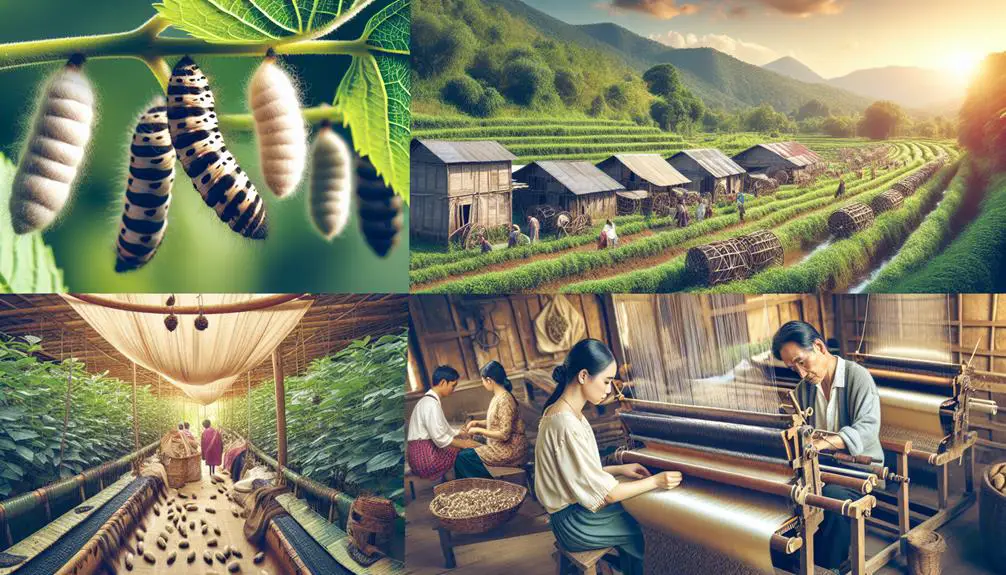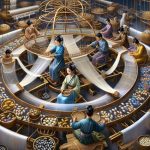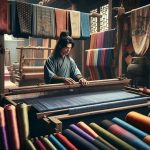Have you ever wondered about the origins of velvet, that luxurious fabric that seems to scream elegance? It's believed that velvet first made its appearance in the Far East, crafted by highly skilled weavers who perfected the art over centuries. As it traveled along the Silk Route to Europe, velvet became a symbol of wealth and power, exclusively worn by royalty and the elite. But there's more to the story of how this opulent fabric woven from the finest silk threads evolved into a staple in the fashion world. What might surprise you is how its production methods have transformed over the years.
Table of Contents
Key Takeaways
- Velvet originated in the Far East before becoming popular through trade routes to Europe.
- It was traditionally made from the finest silk threads by specialized weavers.
- The Silk Route played a crucial role in enhancing access to materials for velvet production.
- Today, velvet is made from various materials including silk, cotton, wool, and synthetic fibers.
- Modern technological advances allow for the integration of electronics and recycled materials in velvet weaving.
Origins of Velvet
Velvet's luxurious texture likely originated in the Far East, becoming a symbol of wealth and power as it traveled through trade routes to Europe. The term 'velvet' itself has a fascinating etymology that traces back to the Latin word 'villosus,' meaning shaggy or tufted. As I dig deeper, it's clear that the evolution of the word reflects the fabric's journey across cultures and centuries.
Diving into velvet's cultural symbolism, it's evident that it was more than just a material; it represented social and economic status. In the early days, owning velvet was the privilege of the rich and powerful—a visible marker of opulence and authority. This association wasn't just superficial; it was woven into the very fabric of societal structures, influencing fashion and art across various dynasties and kingdoms.
Moreover, the allure of velvet wasn't confined to just one region. From the courts of China to the thrones of Europe, velvet was a universal emblem of regality and divine favor. It was cherished not only for its softness and depth of color but also for its ability to signify a much deeper, almost spiritual wealth. This duality of practical luxury and profound symbolism is what truly sets velvet apart in the textile world.
Early Velvet Production
Now, let's explore how velvet was originally produced, shedding light on the techniques that crafted its unique texture. Historically, velvet production was a meticulous craft mastered by specialized weavers. It wasn't just about weaving fabric; it was about creating a piece of art. In the early days, these artisans were often part of medieval guilds, which were associations that not only safeguarded their trade secrets but also guaranteed unmatched quality.
The process began with the finest silk threads—each selected with utmost care. The threads were then woven on a special loom that allowed the weavers to create the dense, raised pile that velvet is known for. This wasn't a quick job; producing velvet required patience and precision, as the dual-layered fabric involved intricate interlacing of threads.
Another key aspect was the dyeing techniques. Achieving the rich, deep colors that velvet is famous for wasn't easy. Artisans used complex dyeing methods, often with natural dyes that provided vibrant, long-lasting colors. They'd to be experts in color mixing and fixation to guarantee that the final product wasn't only beautiful but also durable.
Understanding these early techniques gives us a deeper appreciation for velvet, highlighting the blend of artistic skill and technical knowledge that went into its creation.
Key Silk Route Contributions
The Silk Route played a significant role in exploring the art of velvet weaving across different cultures. As I investigate further, it's clear how pivotal these ancient trade networks were. The Silk Route wasn't just about trading goods—it was a vibrant avenue for cultural exchanges, enriching societies with new crafts, ideas, and technologies.
Here's how the Silk Route specifically elevated the velvet craft:
- Enhanced Material Access: Silk, the primary component of traditional velvet, moved extensively along these routes. This availability made it possible for artisans in various regions to experiment and eventually master velvet production.
- Artisan Migration: Skilled weavers traveled along the Silk Route, settling in new lands and blending their techniques with local practices. This fusion gave birth to unique styles and weaving methods that would have been impossible in isolation.
- Cultural Appreciation: As velvet traveled, it gained a reputation as a material of luxury and status, deeply desired by nobles and royals. This high demand encouraged continuous innovation in velvet weaving techniques, pushing the craft to new heights.
Understanding these impacts shows just how intertwined the Silk trade was with cultural growth. It wasn't just commodities that were exchanged, but a legacy of craftsmanship that enriched the fabric of societies along the route.
Velvet in European Fashion
In European fashion, velvet quickly became synonymous with luxury and opulence, transforming attire across the continent. It was particularly favored in royal attire, where its rich texture and deep sheen communicated wealth and status. Kings and queens draped themselves in velvet robes and gowns, often embellished with intricate embroidery and precious gems. This fabric wasn't just a favorite in the court; it permeated various levels of society, becoming a staple for anyone who could afford its lavishness.
The Baroque period further intensified the love for velvet. Its heavy, sumptuous feel matched the era's aesthetic perfectly, marked by dramatic, detailed, and grandiose art and architecture. Velvet was everywhere—on curtains, upholstery, and in fashion. It was during this time that techniques to produce different types of velvet, such as crushed and cut velvet, were refined, enhancing the fabric's versatility and appeal.
As I explore velvet's journey through European fashion, it's clear this fabric wasn't just a material; it was a statement. Whether gracing the halls of Versailles or the streets of Venice, velvet has left a lasting mark on the fashion landscape, embodying a legacy of elegance that continues to enchant to this day.
Technological Advances in Weaving
As we look at how velvet manufacturing has evolved, it's clear that technological advances have played a huge role.
Innovations in automated looms have sped up production while maintaining quality.
Meanwhile, the integration of smart textiles and enhanced weaving techniques are pushing the boundaries of what velvet can do.
Automated Loom Innovations
Advancements in automated loom technology have greatly transformed the weaving of velvet, making the process faster and more efficient. With loom programming, I can now precisely control how the threads interlace, which drastically improves the consistency of the velvet's plush texture. Adjusting thread tensioning is vital too—it guarantees that each piece of velvet feels just as luxurious as the last.
Here's what makes these innovations truly game-changing:
- Precision: Every thread is perfectly placed, creating a uniform and high-quality fabric.
- Speed: What used to take hours now takes minutes, dramatically boosting productivity.
- Consistency: Automated controls mean less human error, which translates to fewer defects and a more reliable product.
It's a thrilling time for velvet enthusiasts like me!
Smart Textile Integration
Building on the strides made with automated looms, I'm now exploring how smart textile integration can elevate velvet's functionality and appeal. By incorporating smart weaves and electronic integration into the fabric, velvet isn't just about luxury anymore; it's becoming a high-tech player. Imagine velvet curtains that adjust their opacity based on sunlight or cushions that can charge your smartphone. This isn't sci-fi—it's the next step in fabric evolution.
Integrating electronics directly into velvet weaves opens a domain where textiles meet technology, creating both challenges and opportunities. It's about ensuring durability while maintaining the soft, rich texture velvet is known for. This approach doesn't just add value; it redefines what velvet can be in our lives.
Enhanced Weaving Techniques
Velvet's transformation through enhanced weaving techniques showcases a leap in how we craft textiles today. With modern machinery and digital controls, we've pushed the boundaries of what's possible, especially in fabric texturing methods and dyeing enhancements. The results? You've gotta see them to believe it.
- Precision Texturing: New looms offer exact control, creating deeper, more consistent textures that feel luxurious.
- Vivid Colors: Advanced dyeing enhancements mean colors pop like never before, staying vibrant wash after wash.
- Speed and Efficiency: These technologies allow faster production without sacrificing quality, making stunning velvet more accessible.
It's a thrilling time in textile production, where innovation meets tradition, and every new development fuels the passion for creating something truly exquisite.
Materials Used in Velvet Making
Now, let's talk about what velvet is made from.
Originally, velvet was created using only natural fibers like silk, which gave it that luxurious feel and high cost.
But nowadays, there are also synthetic options like polyester and nylon, making velvet more accessible and versatile.
Natural Velvet Fibers
Silk, cotton, and wool are the primary natural fibers used in making traditional velvet. Each of these materials brings a unique charm and texture, enhancing the fabric's luxurious feel. Understanding the nuances of velvet harvesting and cultivation is essential for appreciating its value.
- Silk Velvet: Renowned for its smoothness, producing this involves delicate silk cultivation techniques. It's the epitome of softness and sheen.
- Cotton Velvet: Less expensive but highly durable, cotton velvet offers a matte finish that's perfect for everyday elegance.
- Wool Velvet: Rich and warm, wool velvet is ideal for colder climates, providing a cozy texture that invites you to touch.
These natural fibers, each with their distinct characteristics, make velvet truly versatile and endlessly appealing.
Synthetic Velvet Varieties
While natural fibers like silk, cotton, and wool have traditionally dominated velvet production, modern advancements have introduced a variety of synthetic alternatives. These days, polyester stands out due to its affordability and versatility, driving its popularity in the fashion and upholstery industries.
However, synthetic velvet, particularly polyester, comes with its own set of challenges, especially concerning environmental impact. The recycling challenges are significant because polyester velvet isn't biodegradable and recycling processes aren't yet widespread or highly efficient.
As a result, I'm seeing a growing interest in developing more sustainable practices, including better recycling techniques and the use of recycled polyester. This shift is essential to address the environmental footprint of synthetic velvet production.
The Modern Manufacturing Process
In modern factories, we use advanced technology to weave velvet, ensuring both quality and efficiency. The process starts with selecting high-quality fibers, which can range from natural silk to sophisticated synthetics, depending on the desired outcome. We then move to the weaving phase, where dual layers of fabric are intertwined at the base. This method creates the dense, plush texture that velvet is renowned for.
Chemical treatments play an important role here. They're used to enhance the fabric's durability and to guarantee color fastness, meaning your velvet won't lose its vibrancy after a few washes. It's a meticulous process that combines tradition and technology to protect the fabric's beauty and functionality.
Here's what makes this modern process so emotionally engaging:
- Preservation of Craftsmanship: Despite technological advances, the core of velvet weaving remains an art, preserving centuries-old techniques.
- Sustainability Focus: New methods include eco-friendly practices that minimize waste and reduce chemical usage.
- Innovation and Quality: Innovations ensure each piece of velvet not only looks exquisite but also stands the test of time, blending history with modernity.
This blend of old and new ensures that every yard of velvet isn't just fabric, but a story woven in luxury and innovation.
Velvet and the Fashion Industry
Now let's explore how velvet has become a staple in the fashion industry, revered for its luxurious texture and versatility. This fabric isn't just about aesthetics; its durability makes it a favorite among designers and consumers alike. Velvet's unique structure allows it to withstand more wear and tear than many might expect, which is important for high-use items like jackets and pants.
Consumer perception of velvet has shifted greatly over the years. Initially, it was seen as a material reserved for the elite, due to its opulent feel and higher cost of production. However, advancements in manufacturing have made velvet more accessible, changing its status. Nowadays, it's celebrated not only for its classic elegance but also for its adaptability in both high fashion and everyday wear.
Designers love working with velvet because of its depth and the way it plays with light. This quality adds a dynamic richness to garments that other materials can't replicate. From runway gowns to trendy bomber jackets, velvet has proven its ability to transcend styles and eras, continually reinventing itself within the fashion world. Its enduring appeal in the industry is a tribute to its timeless charm and practicality.
Care and Maintenance Tips
Caring for velvet requires some specific steps to keep its luxurious feel and appearance intact. I've learned that the right approach can make a huge difference. Here's what I do to guarantee my velvet stays pristine:
- Cleaning Best Practices
- Always check the label for specific instructions first. Usually, I prefer to hand wash velvet or use a gentle machine cycle with cold water. I avoid wringing it out; instead, I gently press the water out. For those inevitable stains, I dab gently with a suitable fabric cleaner rather than rubbing, as this can damage the fibers.
- Proper Drying Techniques
- Velvet should never be tumble dried. I lay my velvet items flat on a towel to air dry. This avoids the fabric getting stretched or misshapen by hanging. The key is to keep it away from direct heat sources, as heat can crush the delicate pile.
- Velvet Storage Solutions
- To avoid creases and ensure the pile remains intact, I hang velvet garments on padded hangers. For storage, using a breathable garment bag protects them from dust and light, which can fade the colors over time.
Following these steps, I've managed to keep my velvet looking and feeling fabulous year after year.
Future Trends in Velvet Use
Looking ahead, I'm excited to see how velvet evolves with new sustainable innovations.
There's also a lot of buzz about the latest technological advances that could change how we produce velvet.
Plus, it's thrilling to think about velvet's role in modern fashion, bringing that classic texture back in new ways.
Sustainable Velvet Innovations
As we explore sustainable innovations in velvet production, it's clear that eco-friendly materials and processes are shaping the future of this luxurious fabric. The shift towards sustainability isn't just a trend—it's an essential evolution. Here's why I'm excited:
- Recycled Materials: We're seeing velvets made from recycled plastics and pre-consumer fabric waste. This not only reduces landfill use but also saves energy and water.
- Biodegradable Options: Innovators are developing velvet that can biodegrade under certain conditions, helping to minimize environmental impact once the fabric's life ends.
- Community Impact: Sustainable practices in velvet production support local economies and create jobs that prioritize environmental consciousness.
These advancements are transforming how we think about luxury, making it synonymous with sustainability.
Technological Advances in Production
Building on our focus on sustainability, let's explore how cutting-edge technologies are reshaping velvet production for the future. Digital weaving software is at the forefront, enabling precise control over the texture and design of velvet, which minimizes waste greatly. This software isn't just about better designs; it's about smarter, more efficient production methods that align with our environmental goals.
Additionally, environmental impact analysis is becoming integral in the production process. By evaluating the ecological footprint at every production stage, manufacturers can pinpoint where improvements are necessary. This isn't just good practice; it's a game-changer in reducing the overall environmental load. Moving forward, these technologies won't only preserve resources but also revolutionize the traditional ways we produce velvet.
Velvet in Modern Fashion
Velvet's making a big comeback in modern fashion, with designers pushing its boundaries in exciting new ways. I'm thrilled to see how velvet is evolving, especially with the rise in sustainability and celebrity influences. Here's what's catching everyone's eye:
- Velvet Recycling: Designers are now innovating with recycled velvet, transforming old glamour into new, eco-friendly pieces. This initiative not only preserves the plush texture but also appeals to the environmentally conscious shopper.
- Celebrity Velvet Trends: When celebrities strut in velvet, the world pays attention. Their choices often predict the next big trend, making velvet a staple on red carpets and beyond.
- Technological Textures: Advances in textile technology mean velvet is now more versatile and bold, ready for any runway.
Frequently Asked Questions
Can Velvet Be Dyed at Home Without Professional Help?
Yes, I've successfully dyed velvet at home using proper dyeing techniques to guarantee color fastness. It's key to follow specific fabric care instructions and use suitable dyes for the best results.
Are There Vegan Alternatives to Traditional Velvet?
Yes, there are vegan alternatives to traditional velvet. I've explored both plant-based textiles and synthetic options, which are great for anyone avoiding animal products. They're equally luxurious and come in various styles and colors.
How Does Humidity Affect Velvet's Texture and Appearance?
High humidity affects velvet by increasing moisture absorption, which can alter its texture and lead to color fading. I've noticed it becomes less smooth and slightly duller in appearance with prolonged exposure.
Is Recycled Material Commonly Used in Velvet Production?
Yes, recycled material is increasingly used in velvet production. Fabric sourcing now often includes sustainable options, and production techniques have evolved to incorporate recycled fibers, promoting a greener approach in the textile industry.
What Are the Ethical Concerns Associated With Velvet Manufacturing?
I'm concerned about the ethical issues in velvet manufacturing, especially labor exploitation and heavy chemical usage. These practices harm workers and the environment, pushing me to seek more sustainable and ethical fabric options.
- How Does Ring Spun Cotton Affect Garment Fit and Shape Retention? - August 13, 2024
- What Are the Challenges in Producing Ring Spun Cotton? - August 13, 2024
- Is Ring Spun Cotton Suitable for Plus-Size Clothing? - August 13, 2024






